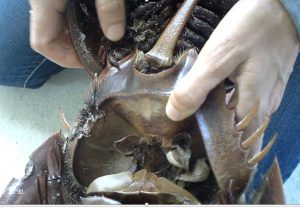Extension connects the general public with University of Florida scientist and specialist by providing research based education. One such research project is University of Florida’s horseshoe crab (Limulus polyphemus) watch. The goal is to identify, tag and record data before gently placing the animals in the surf. Volunteers help track population numbers to better manage these important marine animals.

In 2015, UF launched Limulus watch, a citizen science initiative, training volunteers in surveying, tagging and resighting Florida’s nesting crab populations. This employed a standardized scientific protocol at seven sites on Cedar Key Island (Levy County), New Smyrna Beach (Volusia) and Fort Desoto (Pinellas). In 2017, two sites at Bald Point State Park (Franklin County), Shired Island (Dixie County) and Hagans Cove (Taylor County) were added. Spring of 2018 brought in an additional three beaches at Fort Clinch State Park (Nassau County).
During full and new moons of fall and spring, horseshoe crab congregate for breeding, usually at high tide. They prefer sandy sites in bays or inlets, protected from waves. The female comes ashore to lay approximately 2,000 eggs in a sandy nest buried 3-7 inches deep. One lucky fellow fertilizes the eggs, as they are being laid. Meanwhile, single satellite males hang around awaiting their opportunity to breed.
“Citizen scientists supply the manpower for long term, large-scale study.” Savannah Berry, Ph.D. University of Florida Regional Specialized Agent – Coastal Ecosystems
Why the interest in horseshoe crab?
Harvesting horseshoe crab is necessary to obtain the blood used in human medicine. Horseshoe crabs have blue, copper-based blood that contains a special clotting agent, LAL (Limulus Amebocyte Lysate). LAL clots when exposed to endotoxins, chemical poisons released by certain infectious bacteria. The FDA requires an LAL test on all human and animal injectable and intravenous drugs, on medical devices used to deliver these injectable drugs, and on all prosthetic devices (such as hip replacements or heart valves).*
Limulus blood cells surround bacteria and congeal forming LAL clot. This somewhat cloudy, gelatinous material reminds me of the children play toy slime. LAL clots indicate presence of infectious bacteria. The LAL test is extremely sensitive. As a result, it is the standard for testing all injectables since 1987. Wild caught horseshoe crab are delivered to laboratories where the heart is punctured and some blood extracted. Most horseshoe crab survive the procedure and are released alive.
Horseshoe crab serve an important ecological function. Its eggs are a food source for migratory birds and shore birds. Breeding crabs attracted dozens of birds to our sampling site. Sea turtles, fish and true crabs feed on eggs and horseshoe larva.
What you can do if you find a tagged horseshoe crab.

Never pick up a crab by its tail or telson. This may permanently damage the ball and socket joint at its base or break the tail. The telson helps to steer and right the crab if turned upside down.
Horseshoe crab don’t bite or sting however they do have pointy spines along the lower rim of the shell. Therefore, handle from the front upper portion of the shell. Avoid being poked by picking up with tail facing away from you.
Gently lift from the sand, by placing your hands around the front edges of the carapace to reveal tag. Report the location and tag number to the Florida Fish and Wildlife Commission on dead and living crabs. Call toll-free 1-866-252-9326, or snap a picture and e-mail horseshoe@fwc.state.fl.us. This is one method to track crab migration, populations and health.
Interested in participating in the next Limulus watch?
Master Gardener, Debbie G. (John G and George) provided leadership during this site survey. Her planning and preparation paid off as two ‘newbie’ participants joined in this years survey. Carol and I had a great time! Linda H, Katie G, Marcia P and Linda R, all Extension Master Gardeners, have volunteered at Levy and Dixie county survey sites. Join dozens of Nature Coast Master Gardeners as well as concerned citizens. Contact Tiffany Black, Horseshoe Crab Survey Coordinator, 352-543-1080 or email tiffany.black@myfwc.com.
Hope to see you at a beach nearby. Until then, Happy Gardening!
* sources cited: University of Florida, EDIS publication, The Horseshoe Crab, WEC182
Did you know?
As UF Ambassadors, Nature Coast Master Gardener (MG’s) volunteers provide tremendous value in many ways. They educate residents about science and the scientific process. They inspire young minds to consider science as a career. As citizen scientist, MG’s write newspaper and online articles. They recruit friends into the Florida MG program and participate in UF research efforts.
 0
0
